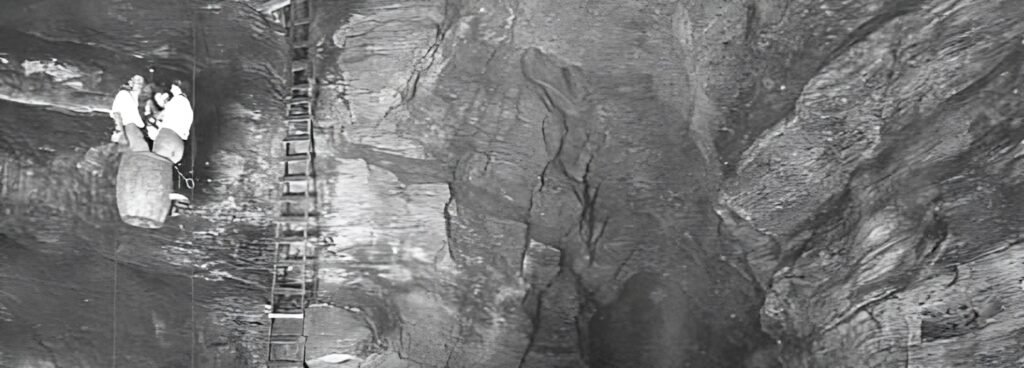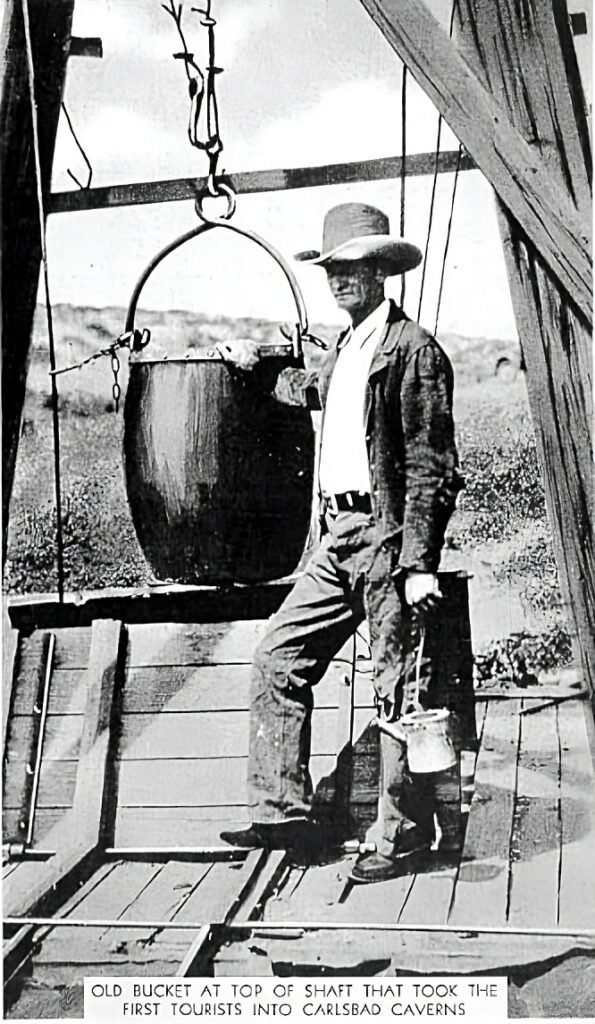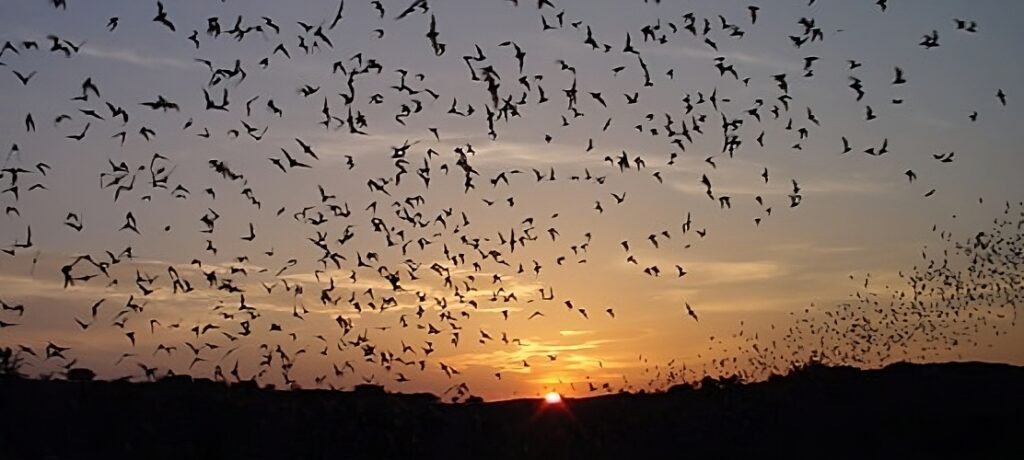
Home of the Bat
I thought it was a volcano—but then I’d never seen one…I had seen plenty of prairie whirlwinds during my life on the range, but this thing didn’t move. It seemed to stay in one spot near the ground—but the top kept spinning upward. I watched maybe a half-an-hour, and being about as curious as the next fellow, I started toward the place.
In 1898, a teenage cowboy rode through the Chihuahuan Desert with a fence-mending posse, keeping their eyes open for wandering cattle. Jim White noted something odd in the distance: smoke. He needed to investigate, as a large wildfire would pose a significant threat to the ranch for which he worked. The smoke didn’t seem to behave like any he had yet experienced. He wondered if it rose from a volcano, a natural phenomenon of which he had heard but never seen.
As he approached, he realized the columns weren’t smoke at all.
“I found myself gazing into the biggest and blackest hole I had ever seen, out of which the bats seemed literally to boil,” White reminisced. He watched as millions of bats emerged from a chasm, noting that “any hole in the ground which could house such a gigantic army of bats must be a whale of a big cave.”

Jim White was not the first human to stumble upon this cave in New Mexico. The Mescalero Apache called it Jadnut udebiga, which translates to “Home of the Bat.” The Zuni Pueblo had a similar name: Ashosti an alaluckwa, which means “Bat Cave.” In the past century, archaeologists found evidence of mescal cooking pits around the entrance to the cave, in addition to a painting on the south wall. White was not the first person drawn by bats to what we now call Carlsbad Caverns, but he was the first to explore it in any substantial way.
White returned a few days later to the cavern with rope, wire, an axe, and a kerosene lantern. He fashioned a makeshift ladder from his materials and lowered himself into the abyss. Even with these crude and insufficient supplies, White immediately understood he had ventured into a monumental system.
He recounted, “The tunnel grew larger with every step. It seemed to me that I was wandering into the very core of the Guadalupe Mountains…I kept going until I found myself in the mightiest wilderness of strange formations a cowboy ever laid eyes on! It was the first cave I was ever in, and I didn’t know then that those formations had names like ‘stalagmites’. But I did know, with the kind of instinct the Creator puts into a man, that there just wasn’t another scene like this one in the whole world.”

His instinct was correct. The rooms and features into which he ventured are some of the continent’s and world’s largest and most majestic.
Quickly, he discovered the Bat Cave, one of the main hideouts for the area’s flying mammals. Inevitably, his lantern exhausted its fuel. White was terrified in the paralyzing darkness: “It seemed as though a million tons of black wool descended upon me.” He had been a prudent explorer, though; a canteen with spare kerosene allowed him to reach the surface again.
White returned to the caverns with another teenager from the ranch, a Mexican who couldn’t speak English known as The Kid. Together, the young men explored the depths. White named some of the components and rooms they encountered, nomenclatures that survive today.
Devil’s Spring. Devil’s Armchair. Devil’s Den. Witch’s Fingers.
As White became less frightened in the darkness, the ominous expressions yielded to more pedestrian, utilitarian names.
The Big Room. Left Hand Tunnel. King’s Palace.

The bats exited and entered the system through the opening we today call the Natural Entrance.
Though only approximately 40 miles of tunnels have been discovered within Carlsbad Caverns – which pales compared to Mammoth Cave, the world’s longest at more than 420 miles, and nearby Lechuguilla Cave’s 150 miles – the rooms within are spectacularly large. The Big Room is the largest chamber in North America. It’s more than 2,000 feet long, 1,000 feet wide, and has a ceiling that reaches up to 255 feet high! That’s 8.2 acres! It’s so large that many people with claustrophobia find they can explore it fear-free.



The evolution of one’s adventure into Carlsbad Caverns is quite the journey.
Jim White started with a rickety ladder and the guts of a space explorer. Eventually, companies began to mine guano – bat excrement – from the caves. White started to use giant guano buckets to lower visitors into the depths. Then a series of planked trails popped up to guide the intrepid caver through the Natural Entrance to the Big Room. In 1923, President Coolidge designated the system a National Monument, which was followed in 1930 with full ordination to National Park status. The National Park Service installed the first elevator system in 1932, which allowed a visitor to bypass the 1.25-mile Natural Entrance trail and go straight to the Big Room.
Today, more than 400,000 people spelunk inside Carlsbad Caverns. Many go straight down from the visitor center to some of the world’s greatest underground monuments, never having to worry about hopping into a guano bucket.


The geologic evolution of Carlsbad Caverns is perhaps even more interesting.
The Caverns are part of the Guadalupe Mountains, which, in eons past, were the opposite of mountains. 250 million years ago, the range was the coastline of an inland arm of the ancient Delaware Basin. What is now the Guadalupe Mountains was then the Capitan Reef, thriving under a saltwater pall. After the Permian Period, the Delaware dried away. Over time, the Capitan Reef became covered in evaporites – leftovers from the sea – and new sediment. Once covered by water, the reef now lay buried by solids. During the late Cenozoic era, plate tectonics wreaked havoc on the region. Now, the twice-buried reef suddenly found itself far above sea level! Since then, the elements have eroded the sediments on top of the reef, leaving only limestone. Today, the Guadalupe Mountains are literally composed of an ancient reef!
Above ground, this geologic journey produced some incredibly jagged, gnarly mountain forms. But limestone is also susceptible to dissolution by acid, meaning they are prone to the formation of caves. Hydrogen sulfide from petroleum beneath the reef seeped upwards, where it mixed with oxygen from groundwater to form sulfuric acid. Over millions of years, the acid worked on the limestone to carve Carlsbad Caverns and the other cave systems of the region.
The Natural Entrance is a relatively modern happening. It appeared sometime in the past million years. Rainwater began to percolate through the system, bringing carbon dioxide to the giant rooms carved by sulfuric acid. When the water evaporates, it leaves calcium carbonate on the ceilings, floors, and walls. The result is as if a group of master sculptors had millions of years and unending material with which to craft wonderworks.

The size and scope of the Caverns – the Natural Entrance section and the Big Room – are hard to comprehend without experiencing them firsthand. And they are just a fraction of the entire system. The named rooms and speleothems – stalactites, stalagmites, soda straws, draperies, popcorn, and flows – seem to be innumerable.
Balloon Ballroom. Green Lake Room. Hall of the White Giant. Lake of the Clouds. Queen’s Chamber. Spirit Room. The Rookery. Underground Lunchroom.
The Caveman. The Chandelier. Chinese Theater. Longfellow’s Bathtub. Rock of Ages. Temple of the Sun. The Totem Pole. Giant and Twin Domes. Silent Bell. Bottomless Pit. Lion’s Tail.
The list goes on and on. And the list won’t be complete anytime soon. Explorers have noted, over the past several decades, several holes in the ceilings of known rooms. Since these canopies reach so high, researchers needed to get creative to reach them. One method includes using a helium balloon to raise a line to massive stalactites, which allows a climbing rope to surround the massive pillars. Intrepid cavers then ascend through the roof. Massive new rooms – dubbed The Spirit World and Halloween Hall – suddenly presented themselves.
What other wonders wait in Carlsbad?



One wonder that continues to thrill visitors is the horde of Brazilian (or Mexican) free-tailed bats that call Carlsbad home for half the year. From April or May to October or November each year, hundreds of thousands of bats roost in the caverns. Each day near sunset, the droves leave the dark confines to feast on insects. They rise in a counter-clockwise spiral, creating an enchanting display.
This daily display drew Jim White to Carlsbad and continues to draw thousands of humans today.

The bats are a wonderful Carlsbad metaphor. They spend their days underground, among the unique formations. But this glorious system sits below the Chihuahuan Desert and the Guadalupe Mountains, a majestic ecosystem of canyons and arid wildlife. At Carlsbad Caverns National Park, one can engage in ineffable beauty above and below the ground.
Further Reading and Exploration
Carlsbad Caverns National Park – Official Website
Jim White’s Story of Carlsbad Caverns
The Indians of Carlsbad Caverns National Park by Jack R. Williams (1956)
Jim White, Cave Explorer – National Park Service
Geology Of Carlsbad Caverns National Park – U.S. Geological Survey












Pingback: Guadalupe Peak Redux – Texas’ High Point – themountainsarecalling.earth